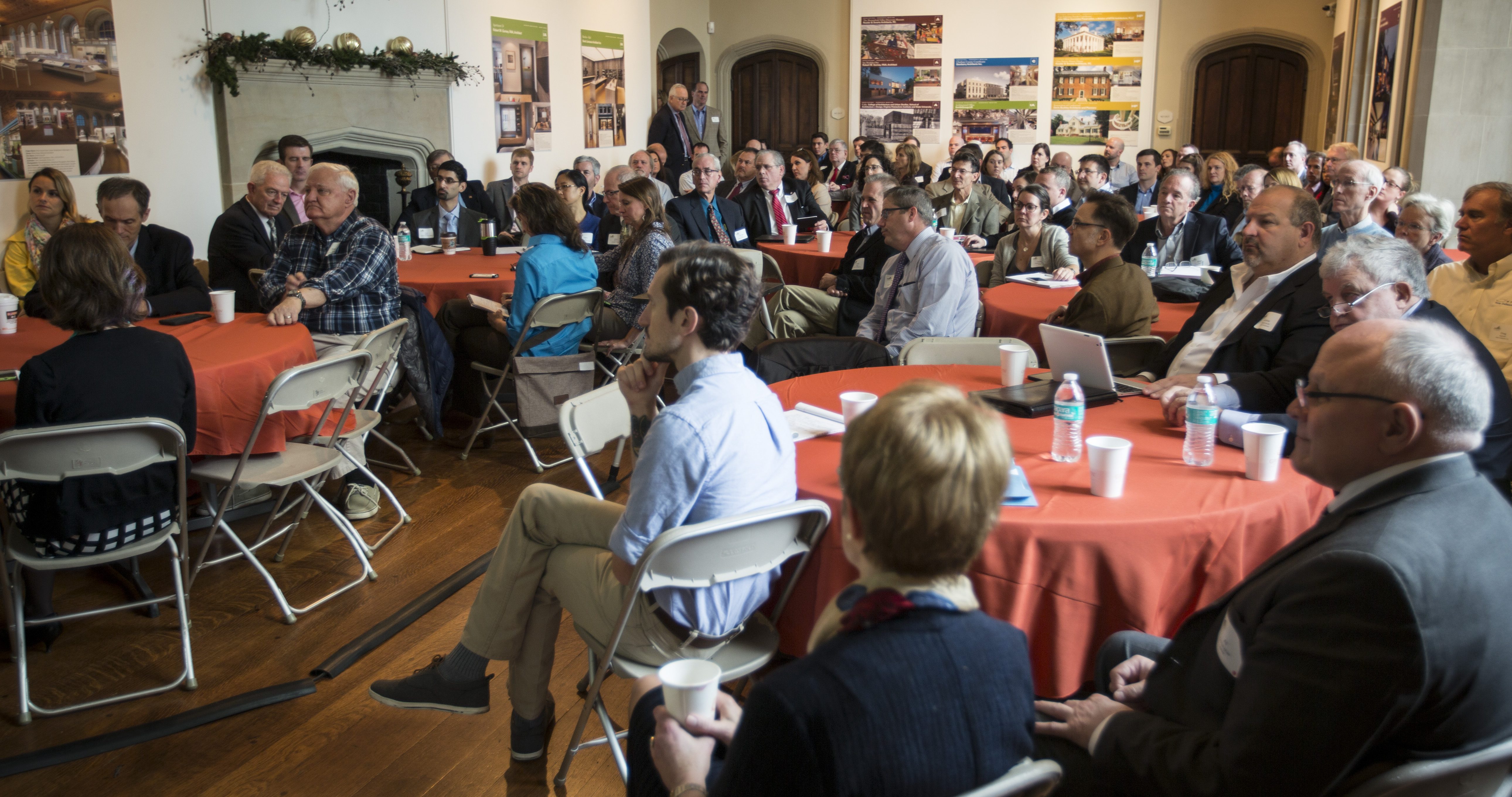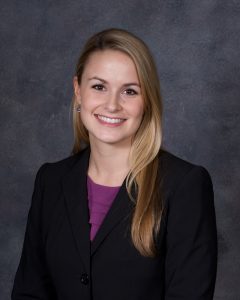 Guest Post by: Stuart Nuckols, Viridiant (Associate Member)
Guest Post by: Stuart Nuckols, Viridiant (Associate Member)
The American Council for an Energy Efficient Economy’s (ACEEE) 2015 State Energy Efficiency Scorecard[1] ranks Virginia 31st in the country for Energy Efficient Programs and Policies. While this may be discouraging to organizations and businesses invested in making the Commonwealth more energy efficient, there is positive energy efficiency policy news to share.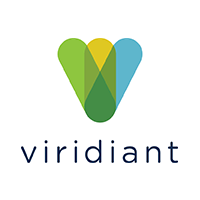
In the last 10 years, Virginia Housing Development Authority (VHDA) and Viridiant, formerly EarthCraft Virginia, have made tremendous progress to successfully implement energy efficiency measures in low income, affordable housing.
Beginning in 2007, VHDA implemented an incentive in the Low-Income Housing Tax Credit (LIHTC) program that encouraged developers to pursue a recognized third-party standard, including Viridiant’s EarthCraft Multifamily program. This successful partnership has resulted in over 230 developments representing more than 16,000 certified apartments in Virginia.
With a substantial number of developments pursuing energy efficient construction, there was an interest in understanding the efficacy of VHDA’s policy decision to promote energy efficient construction in the Virginia rental housing stock. After initial funding from VHDA to benchmark and track unit-level performance of four EarthCraft Multifamily certified projects that had utilized Low Income Housing Tax Credits brought exciting findings, Viridiant partnered with Housing Virginia and the Virginia Center for Housing Research (VCHR) at Virginia Tech to publish a first-of-its-kind study that demonstrates the impact of energy efficient incentives in the construction of affordable rental housing in Virginia.
The 2015 report, The Impact of Energy Efficient Design and Construction on LIHTC Housing in Virginia[2], shows that the average EarthCraft Multifamily apartment reduces monthly energy consumption by 464 kilowatt hours saving $54/month on electricity, which amounts to annual savings of $648 and 5,568 kilowatt hours.
In addition to the energy and utility cost analysis, the research team deployed an anonymous survey to residents to gain insight into housing satisfaction, comfort, thermostat set points, appliance use, etc. In general, residents sampled in the study were more satisfied, more comfortable and paid lower utility costs compared to previous housing. An unanticipated finding of the study was the value observed in the independent, third party verification process that was instrumental in helping development teams achieve their energy and sustainability goals.
The study is one of the first in the nation to evaluate unit-level electricity consumption of affordable apartments built to exceed current efficiency standards. Of the 230 EarthCraft Certified Multifamily projects, 15 projects were selected to ensure representation of building type, geographic location, resident population and both new construction and renovation. Using actual utility performance, unit-level energy projection models, building information, and resident surveys, the team concluded that, on average, units performed 16.6% better than Viridiant had modeled, outperforming standard construction by 30%.
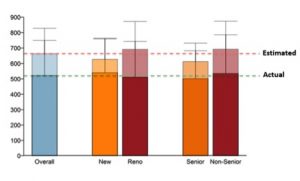
Figure 1: Monthly averages for estimated energy consumption (energy model) vs. observed energy consumption in certified EarthCraft Multifamily projects.
With savings reported in this study at almost $650 a year on average and over 16,000 EarthCraft Multifamily dwelling units in Virginia, the projects have the potential to save residents over $10 million in 2016 alone.
A continuation of the study is underway to assess construction costs of energy efficient construction and scheduled to be released in 2017.
About Viridiant
Viridiant will continue to support the industry with the EarthCraft family of green building programs, but the organization is also looking to broaden its reach and mission. Recently rebranded as Viridiant, the organization plans to add more services and certifications in areas such as in-home energy monitoring, utility allowances, online energy assessment tools and unbiased consultation on specialties such as solar energy and energy-efficient home mortgages.
The new name, which is derived from a combination of “viridis,” the Latin word for “green,” and “-ant” of “servant” for their mission-driven stewardship, recognizes the group’s expansion into Washington, D.C. and Maryland, and its intention to do more to demonstrate how the latest building science can set a path for businesses and homeowners to create structures that are more affordable, livable and durable.
Viridiant offers win-win solutions for anyone who is interested in living in or building better buildings. “From net-zero to environmental sustainability and improved air quality, we are well versed in helping our partners exceed their goals to deliver high quality products and avoid construction pitfalls,” said KC Bleile, Viridiant’s Executive Director. “Having served nearly 20,000 families and 325 building partners, we’re excited to use what we’ve learned to expand our programs and reach to serve twice as many families over the next ten years.”
Over the coming months, Viridiant will begin to pilot, test and launch new programs and services to serve their broader goals.
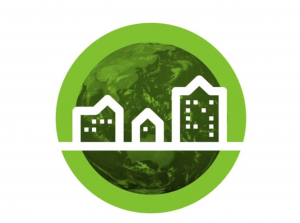 Find out how their new name embodies the vision for their organization in this video.
Find out how their new name embodies the vision for their organization in this video.
[1] http://aceee.org/state-policy/scorecard
[2]Virginia Center for Housing Research (VCHR), Virginia Tech, 2015. The Impact of Energy Efficient Design and Construction on LIHTC Housing in Virginia, Contract Report submitted to Housing Virginia, Richmond, VA. Retrieved January 15, 2016, from http://www.vchr.vt.edu/wp-content/uploads/2015/02/Housing-VA-LIHTC-Study-Full-Report.pdf
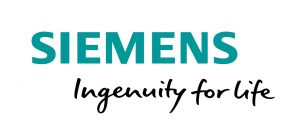 For over 165 years, Siemens has built a reputation for delivering leading-edge products and services, high levels of customer satisfaction, and an unending spirit of innovation. As a $100B company with over 370,000 employees in 190 countries, Siemens is a global powerhouse in electronics and electrical engineering, industry, energy, healthcare, infrastructure, and building automation.
For over 165 years, Siemens has built a reputation for delivering leading-edge products and services, high levels of customer satisfaction, and an unending spirit of innovation. As a $100B company with over 370,000 employees in 190 countries, Siemens is a global powerhouse in electronics and electrical engineering, industry, energy, healthcare, infrastructure, and building automation.
From initial assessment through ongoing support, the Building Technologies Division of Siemens Industry, Inc. is the world market leader for safe, reliable, energy-efficient, and sustainable buildings and infrastructures. As a service provider, system integrator, and product manufacturer, Siemens offers sustainable building products, technologies, and solutions that help optimize building automation, fire safety and security systems, HVAC, air quality, power distribution and management, and energy efficiency. Our systems, services, resources, and experience help ensure facilities are safe, efficient, and compliant.
As a true full-service energy services company (ESCO), Siemens provides the industry’s most comprehensive end-to-end energy solutions – from energy reduction to production and procurement – enabling cities to best achieve energy and water goals while positively impacting the economy and environment. Siemens extensive expertise in guaranteed performance-based solutions, combined with our scalable, proven portfolio, allows us to most efficiently and effectively meet the needs of all communities, including small-, medium-, and large-sized cites.
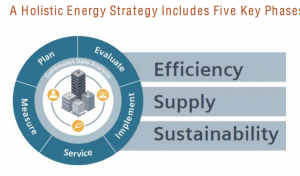
Siemens Commissioning Advantage Program (CxA) is a comprehensive building energy and performance optimization program designed to improve the way facility mangers operate their facilities. This program includes a variety of individual offerings that have a far greater impact when combined as a holistic solution.
Siemens’ white paper, “Commissioning: An Essential Part of a Comprehensive Energy Strategy,” talks about how and why Commissioning should be included in a company’s energy plan. Here is an excerpt from that white paper:
“Through proper assessment and planning, a comprehensive energy strategy that includes commissioning will serve as a roadmap to maximize building performance. A fragmented approach to commissioning can compromise the long-term health of the building; it is important to integrate commissioning into a facility’s energy management strategy. Depending on the building’s level of energy-efficiency, age, and use, the commissioning approach will be comprised of both one-time initiatives and ongoing services, and both are designed to reduce energy costs while enabling continuous performance improvements.”
A Holistic Energy Strategy Includes Five Key Phases
- Strategy & Planning
- Evaluation & Assessment
- Program Implementation
- Ongoing Services & Optimization
- Measurement & Reporting
Learn more at www.usa.siemens.com/commissioning or contact:
Janet S. Tribble
Siemens Industry, Inc.
Building Technologies Division
Business Development, Building Performance & Sustainability
janet.tribble@siemens.com
804-426-1980
We enjoyed the spring meeting last week and hope that you did too. We received many positive remarks on the venue, so we may just have to hold another event at the University of Richmond Jepson Center.
In case you missed it, below are some highlights from the day and links to download the presentations. You can also see photos on our Facebook page — be sure to tag yourself and your colleagues.
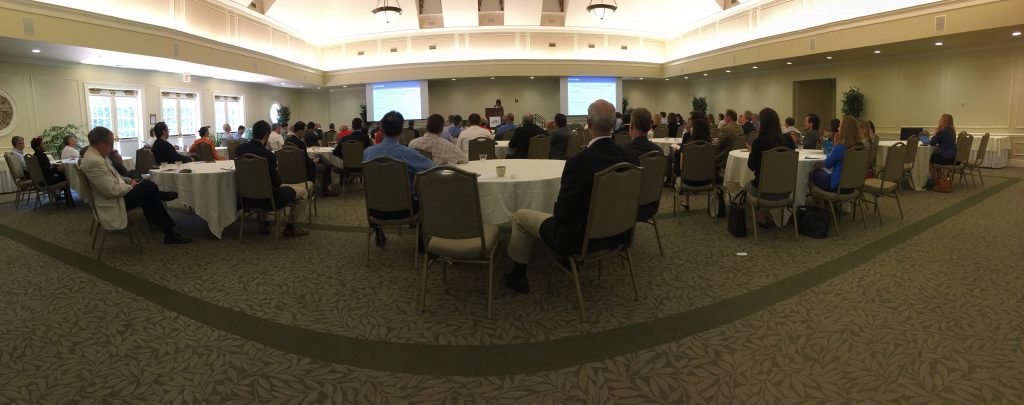
To kick off the event, we unveiled a new logo and website! This took many hours of hard work, and we are pleased with the end result. I hope you will check out the rest of the site while you’re here.
I also ran through some of the key data from the member survey. It’s very clear that you, our members, enjoy being part of a broad coalition that is driving energy efficiency policy and programs in Virginia.
We received positive feedback on our communications and potential new member-only benefits. We also heard that you want more networking and training opportunities such as webinars, so later this month we’ll launch our webinar series. We asked and you answered so the first webinar topic will be on PACE financing. The date is set for June 30 at noon. Details will follow soon.
The VAEEC membership also reappointed 3 of our board members and voted on two new members to expand the board to 13. You can see all of our board members here.
After my remarks, Hayes Framme, from the office of Governor McAuliffe, 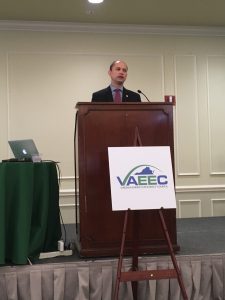 gave an update on the 2016 General Assembly session and the work of the Governor’s Executive Committee on Energy Efficiency (GEC). Hayes told the crowded room about SB 395 and HB 1053, which were bills the Governor initiated. The final outcome for these bills, which wasn’t the initially hoped for outcome (as detailed here), directed the State Corporation Commission to open a public comment period in order to draft a response on the feasibility of developing protocols to verify savings of utility programs. The VAEEC supported these bills during session and our full comments to the SCC can be found here.
gave an update on the 2016 General Assembly session and the work of the Governor’s Executive Committee on Energy Efficiency (GEC). Hayes told the crowded room about SB 395 and HB 1053, which were bills the Governor initiated. The final outcome for these bills, which wasn’t the initially hoped for outcome (as detailed here), directed the State Corporation Commission to open a public comment period in order to draft a response on the feasibility of developing protocols to verify savings of utility programs. The VAEEC supported these bills during session and our full comments to the SCC can be found here.
Hayes also discussed the GEC itself, for which we have a dedicated page on our website as we are a partner of the state energy office in providing support to the GEC’s work.
Next up was John Morrill with Arlington County to discuss the progress of the DEQ stakeholder group that is helping DEQ identify the commonwealth’s compliance path for the Clean Power Plan. John mentioned that consensus was hard to come by among the stakeholders, but more importantly, consensus was reached that all stakeholders like pie. Details were not shared on which kind.
Following the lunch networking break, we picked the agenda back up with 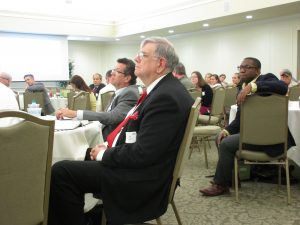 three more presentations. First was Ryan Hodum with David Gardiner & Associates — also our newest member! Ryan presented on two of DGA’s initiatives: Chambers of Innovation for Clean Energy, a program that is engaging local Chambers of Commerce on clean energy issues, and the Alliance for Industrial Efficiency, which which focuses on state and federal industrial energy efficiency policy, primarily on combined heat and power.
three more presentations. First was Ryan Hodum with David Gardiner & Associates — also our newest member! Ryan presented on two of DGA’s initiatives: Chambers of Innovation for Clean Energy, a program that is engaging local Chambers of Commerce on clean energy issues, and the Alliance for Industrial Efficiency, which which focuses on state and federal industrial energy efficiency policy, primarily on combined heat and power.
Next, was the Featured Member of the month. For May, we featured, Pearl Certification. Cynthia Adams, VAEEC’s board chair is CEO of this new company, which helps homeowners save money through energy savings but also helping them recapture some of the value of their home improvement investment if they decide to sell later on.
Our final presentation of the day was by Zack Miller with Virginia Housing Alliance who discussed the initiatives of the Multifamily Energy Efficiency Coalition (MFEEC). Multifamily housing accounts for 12% of Virginia’s total housing stock, equal to 385,000 units. These residences are typically left out of energy efficiency programs, so the coalition is working to advance policies that provide comprehensive energy efficiency services to this sector. The VAEEC and many of our members are proud to be part of this worthwhile initiative.
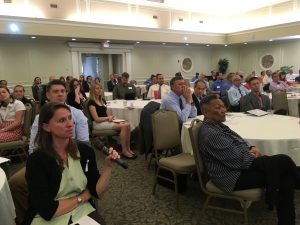 We spent the last 30 minutes of the meeting giving our members the opportunity to brag a little bit. A microphone was sent around for members to give a 2-3 minute update on anything they are working on related to energy efficiency. Dominion Virginia Power, Columbia Gas and Washington Gas all gave updates on their energy efficiency programs and their latest proceedings before the SCC. Several other members gave updates as well including Trane, Viridant, Virginia Community Capital, and Loudon County Public Schools. We are pleased that so many members chimed in to talk about their work.
We spent the last 30 minutes of the meeting giving our members the opportunity to brag a little bit. A microphone was sent around for members to give a 2-3 minute update on anything they are working on related to energy efficiency. Dominion Virginia Power, Columbia Gas and Washington Gas all gave updates on their energy efficiency programs and their latest proceedings before the SCC. Several other members gave updates as well including Trane, Viridant, Virginia Community Capital, and Loudon County Public Schools. We are pleased that so many members chimed in to talk about their work.
Our next member meeting will take place in November where we will hold our first annual Energy Efficiency Champions awards ceremony. Stay tuned for details.
Links to Presentations:
General Assembly Recap and Governor’s Executive Committee on Energy Efficiency Update (Hayes Framme: Virginia’s Chief Energy Efficiency Officer)
Clean Power Plan Update (John Morill: Energy Manager for Arlington County, VAEEC Goverance Board and member of the Governor’s Clean Power Plan Stakeholder Group)
Chambers of Innovation (Ryan Hodum: Vice President, David Gardiner and Associates)
Member Spotlight (Cynthia Adams: Pearl Certification)
Multifamily Housing Coalition Update (Zack Miller: Policy Director, Virginia Housing Alliance)
May 2016
Pearl National Home Certification
Business Silver Member
Pearl National Home Certification is a Virginia-based startup launched in 2015. Pearl is dedicated to increasing the energy efficiency and comfort of existing homes and will transform the market by helping homeowners capture the value of their home energy upgrades for resale or refinance. Network contractors and real estate agents grow their businesses when they become Pearl Partners by providing their clients access to Pearl’s special services, such as exclusive rebates and lending products, and a “My Home Profile” account to track progress towards certification.
At the helm are Co-Founders Cynthia Adams, also founder and President of the VAEEC and formerly the Executive Director of the Local Energy Alliance Program; and Robin LeBaron, formerly Managing Director of the National Home Performance Council. Pearl is an official partner with the Department of Energy’s Home Performance with ENERGY STAR program, running pilots in central and northern Virginia.
How Does Pearl Work?
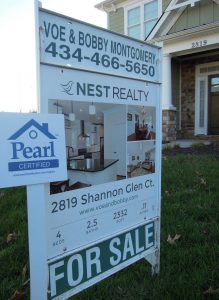 Pearl’s certification service is used by contractors to verify and score a home’s energy assets for certification. When a home’s features earn it enough points, Pearl issues a BRONZE, SLIVER, GOLD, or Net Zero certificate and Home Energy Asset Inventory report. Real estate agents use Pearl’s services to help sellers market their energy efficient home and to help buyers maintain and improve their “new” home through an exclusive “My Home Profile” account. “My Home Profile” provides homeowners with a plan to achieve certification, as well as online resources for maintaining their home. Pearl’s software also functions like a virtual general contractor, helping homeowners find contractors to make improvements and tracking progress made over time.
Pearl’s certification service is used by contractors to verify and score a home’s energy assets for certification. When a home’s features earn it enough points, Pearl issues a BRONZE, SLIVER, GOLD, or Net Zero certificate and Home Energy Asset Inventory report. Real estate agents use Pearl’s services to help sellers market their energy efficient home and to help buyers maintain and improve their “new” home through an exclusive “My Home Profile” account. “My Home Profile” provides homeowners with a plan to achieve certification, as well as online resources for maintaining their home. Pearl’s software also functions like a virtual general contractor, helping homeowners find contractors to make improvements and tracking progress made over time.
Why Homeowners Sign Up with Pearl
Pearl offers homeowners:
- An initial estimate of the home’s certification level through a free My Home Profile account
- Information on rebates and loans to help pay for energy, health and other home improvements
- Access to a network of high-quality, specially trained Pearl-Approved Contractors
- Certification of a home’s energy efficient and health features
- Documentation and marketing services to help sell a certified home
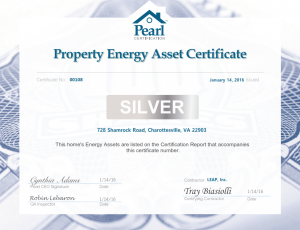 Interested homeowners who want to sign up for Pearl can do so here: www.yourhomeprofile.com.
Interested homeowners who want to sign up for Pearl can do so here: www.yourhomeprofile.com.
You can check out a sample certification report here.
How Contractors Benefit with Pearl
Pearl’s software provides quality contractors a marketing and certification system to enhance home performance and energy efficiency sales. Network contractor benefits include:
- Client engagement from the first appointment on
- Increased job size through certification services
- Relationship marketing through Pearl’s email services
- Homeowner referrals from Pearl Partners
- Differentiation from low bid/low quality competitors
This list of benefits results in increased revenue for contractors: the average insulation sales person can generate over $100K in additional yearly sales with Pearl, and the average HVAC sales person double that number. To learn more about how contractors can grow their business with Pearl, visit www.pearlcertification.com/contractor.
How Real Estate Agents Benefit with Pearl
Realtors have been among Pearl’s earliest and strongest partners, given the mutual interest in helping home buyers create value, and sellers access it.
The National Association of Home Builders found that nine out of ten buyers would rather purchase a home with energy-efficient features, and would be willing to pay more for it. A recent study by the Appraisal Institute and the Institute for Market Transformation found that Washington, D.C. homes that were certified energy efficient sold for a 3.6% price premium. It’s representative of what we’re seeing across markets in the U.S. where, on average, third party certified homes are selling for 4-5% higher. On a $500K home, this can be $25K in added value sellers are currently leaving on the table.
As a Pearl Partner, real estate agents get:
- Buyer’s closing gift of a Pearl “My Home Profile” account
- Monthly client emails with informative and timely maintenance tips
- Training on selling the energy efficient home
- Special certification report package and other marketing tools for selling the certified home
- Client referrals from our Pearl Network contractors
 Real estate agents interested in learning more should visit pearlcertification.com/homevalue/
Real estate agents interested in learning more should visit pearlcertification.com/homevalue/
We’ve got a great agenda lined up for the May 26th VAEEC meeting, including a presentation by Ryan Hodum of David Gardiner and Associates about Chambers for Innovation and Clean Energy (CICE), a national clean energy information hub and network for local chambers of commerce.
 Created and led by local chambers of commerce, CICE helps fellow chambers and their member companies navigate and prosper in the clean energy and innovation spaces. CICE shares best practices and case studies, connects chambers with sought-after experts and high-level decision makers, promotes the clean energy work being done by local chambers, and helps chambers find incentives and financing for new clean energy initiatives.
Created and led by local chambers of commerce, CICE helps fellow chambers and their member companies navigate and prosper in the clean energy and innovation spaces. CICE shares best practices and case studies, connects chambers with sought-after experts and high-level decision makers, promotes the clean energy work being done by local chambers, and helps chambers find incentives and financing for new clean energy initiatives.
CICE has been active in Virginia. During the annual Virginia Association of Chamber of Commerce Executives conference in March, CICE sponsored a conference session moderated by the Roanoke Regional Chamber of Commerce to discuss the economic opportunity of clean energy in the Commonwealth. Following the conference, local chambers and member companies joined the Virginia Governor’s Advisor for Infrastructure and Development, Hayes Framme, for a conversation about the economic development opportunities of clean energy.
You can check out some local chamber perspectives via videos on the CICE Facebook page.
Join us May 26th to learn more about Chambers for Innovation and Clean Energy.
By: Chelsea Harnish, VAEEC Executive Director
Back in March, the VAEEC provided support for utility energy efficiency programs that were being reviewed by the State Corporation Commission (SCC).
I testified (you can read the testimony here) in favor of Dominion’s three proposed programs that would have benefited a wide variety of consumers, including a rebate program for residential customers who purchase wifi thermostats, an expansion of Dominion’s air conditioning recycling program, which pays consumers to allow their units to cycle during peak demand and finally, a small business improvement program to help this customer base update aging energy infrastructure.
Dominion received notification from the SCC on April 19. Here is a brief summary of the outcome:
- The proposed Residential Thermostat Program was denied.
- The extension for the AC cycling program was approved.
- The proposed Small Business Improvement program was approved for five years, but the budget was reduced by 50%.
The VAEEC also submitted comments (read them here) in support of the expansion of Washington Gas’s CARE program. Initially, the utility was seeking $12.3 million for the proposed expansion of the program over 3 years but the SCC only approved $6 million for the same time period. Despite this setback, the utility says they are excited about the benefits these programs will provide to Virginia utility customers. One exciting note on the new program expansion includes more than doubling the number of customers who can take advantage of the Home Energy Report program, which helps consumers take control of their energy usage and reduce their monthly energy bills.
The VAEEC will hold Governance Board elections at the May 26 meeting. Voting is open to all current VAEEC members. Each member entity will receive a single paper ballot.
Below are the candidates up for election and reelection to the Board.
VAEEC’s Bylaws allow for up to 15 Directors, each with a 3-year term. Directors can serve on unlimited consecutive terms. With the reappointment of the 3 current Directors whose initial terms have expired, and the addition of two new Directors on May 26, the Board would be composed of 13 Directors with plans to add 2 more Directors in the coming years.
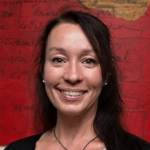
Cynthia Adams
Pearl National Home Certification
2nd Term
As one of the VAEEC’s founders, I’m dedicated to seeing its successful growth and impact in Virginia, and I’ve worked over the years to bring in both public and private funding to support its mission. I want to continue to champion public-private partnerships for growing the energy efficiency industry, a coordinated approach for education and outreach, and regulatory policies that leverage the many benefits energy efficiency as a resource can bring.
Cynthia Adams is CEO of Pearl Certification, a Virginia-based company whose software platform is used by contractors and real estate agents to verify and certify a home’s energy assets and increase its value. She was previously Executive Director of the award-winning Local Energy Alliance Program (LEAP), an energy services nonprofit, which under her leadership developed innovative energy efficiency and solar programs that helped thousands of building owners in central and northern Virginia reduce and produce energy. A fifteen year veteran in the green construction field, Ms. Adams has worked as a partner in a consulting company for sustainable building, part-owner of a sustainable design showroom, and co-founder of a green design-build construction company. In 2014, Ms. Adams was elected to the national board of Efficiency First and appointed by Governor McAuliffe to the Virginia Energy Council. In 2015 she was appointed to the Governor’s Executive Committee on Energy Efficiency.

Bill Beachy
Community Housing Partners
2nd Term
I am interested in continuing to serve on the VAEEC Board in order to represent and express the needs of low-income Virginians in discussions regarding energy efficiency programs and policies that effect their lives.
Bill Beachy has 36 years experience in the weatherization and energy efficiency fields. He is Vice President of Energy Solutions Field Operations at Community Housing Partners based in Christiansburg, Virginia. Previously he served for 10 years as the state manager of the Virginia Weatherization Assistance Program for the Virginia Department of Housing and Community Development. Bill has a bachelor’s degree from James Madison University and a master’s degree in Public Administration from Virginia Commonwealth University. He is the current President of the Board of Directors of the Association of Energy Conservation Professionals (AECP), a trade organization of the Virginia weatherization network. Bill is also a member of the national Network (Evaluation) Committee; member of the national Weatherization Trainers Consortium; and a member the Department of Energy’s National Training and Technical Assistance Plan advisory group.

Bill Greenleaf
Virginia Community Capital
2nd Term
I want to serve on the Board of the VAEEC to provide leadership and guidance in our effort to advance PACE energy efficiency loan programs and educate regulators and policy makers about the importance of energy efficiency in Virginia.
Bill Greenleaf is a Vice President and Loan Officer for Virginia Community Capital. In 2015, Bill helped VCC launch their energy efficiency and solar loan products and is one of four Virginia Energy Efficiency Council governance board members appointed to the Governor’s Executive Committee on Energy Efficiency. Previously, Bill was the Executive Director of the Richmond Regional Energy Alliance and Chief Operating Officer of an international sustainable design firm. Bill received his undergraduate degree in economics from Skidmore college and his MBA from the Kelley School of Business at Indiana University.

Carla Dix
Columbia Gas of Virginia
1st Term
I am interested in serving on the VAEEC Board in order to help advance energy efficiency in Virginia and provide insight from the natural gas utility perspective.
Carla Dix is the Lead Performance Analyst for Columbia Gas of Virginia’s energy efficiency program, WarmWise. In her role, she works daily with outside partners on various functions of the programs, including rebate processing, education and outreach, evaluation, measurement and verification, program design, low income support, and customer service. Prior to joining Columbia Gas of Virginia in 2012, Carla preformed revenue management for Starwood Hotels & Resorts. She holds a Bachelor of Science degree from Virginia Polytechnic Institute and State University in Blacksburg, Virginia.

Thomas Nicholas
City of Virginia Beach Department of Public Works
1st Term
I am interested in serving on the VAEEC Board because I have the professional background and current, local governmental responsibility of developing and enacting energy policies, programs and technologies that enable me to contribute to the discussion of energy efficiency as a resource in Virginia. As an advisory member, I hope to share my experiences and at the same time, serve as a conduit for interaction with industry to express their desires and concerns regarding energy efficiency with one of the largest municipalities in the Commonwealth.
As Facilities Engineer with the City of Virginia Beach Department of Public Works, Thomas Nicholas oversees the Facilities Design and Construction Division, Building Maintenance Division, Facilities Management Office and Energy Management Office. He serves as the focal point for all municipal building planning, design, construction, maintenance, facilities management and energy programs. A retired Naval officer, Tom has extensive facilities management experience with the U.S. Navy. During his 24-year career, he managed Navy facilities in Guam, the Philippines, Alaska, Hawaii, California, the Republic of Panama, Italy and the Mid-Atlantic. He has degrees from the U.S. Naval Academy and Penn State University.
Here is a history of the VAEEC Governance Board:
Original VAEEC Board elections were held at the October 2012 VAEEC Meeting. Original Executive Committee Elections were held in September, 2013:
Steve Walz, President
Cynthia Adams, Vice-President
Bill Greenleaf, Treasurer
Andrew Grigsby, Secretary
Steve Walz resigned from the board in February, 2014. Cynthia Adams became President in March 25, 2014. On December 17, 2014 the new EC was voted in:
Cynthia Adams, President
David Steiner, Vice- President
Bill Greenleaf, Treasurer
Andrew Grigsby, Secretary
Current (As of May, 2016) Governance Board:
Cynthia Adams, Pearl National Home Certification
Bill Beachy, Community Housing Partners
Larry Cummings, Trane
Bill Greenleaf, Virginia Community Capital
Andrew Grigsby, Local Energy Alliance Program
Tom Jewell, Dominion Virginia Power
David Koogler, Rappahanock Electric Cooperative
John Morill, Arlington County
Saifur Rahman, Virginia Tech
David Steiner, D+R International
Marissa Uchin, OPower
More on voting procedures from the VAEEC Bylaws:
Section 5. Representatives. Each member, other than a member who is an individual, shall by written notice to the Board of Directors, the President or the Secretary designate as its representative an individual who shall be authorized to act on behalf of such member. Any member may at any time by written notice to the Board of Directors, the President or the Secretary remove any representative designated by such member and designate a replacement of or successor to the same.
Section 21. Proxies. A member entitled to vote may appoint a proxy to vote or otherwise act for him by executing and dating an appointment form, either personally or by its attorney-in-fact. No appointment of proxy shall be valid after the expiration of 11 months from the date of its execution, unless otherwise provided therein. Every appointment of proxy shall be revocable by the member executing it, unless the appointment form conspicuously states that it is irrevocable and that it is coupled with an interest in accordance with law.
 Since our last post about PACE (Property Assessed Clean Energy) in Virginia, we continue to move the needle forward on PACE financing in our state. In early April, Virginia Community Capital released the final recommendations from our Oak Hill Fund grant.
Since our last post about PACE (Property Assessed Clean Energy) in Virginia, we continue to move the needle forward on PACE financing in our state. In early April, Virginia Community Capital released the final recommendations from our Oak Hill Fund grant.
Although we concluded that a statewide program administrator would be the ideal solution to ensure rapid advancement of PACE in Virginia, we also concluded that there is no known existing funding to support the creation of statewide program administrator. However, Abacus Property Solutions assisted the Virginia Department of Mines, Minerals and Energy (DMME) in responding to a Department of Energy State Energy Program (SEP) grant that, if awarded, would provide Virginia and partner states, Maryland and District of Columbia, with $500,000 in PACE funding across our region. This three-year grant would help seed and develop statewide PACE efforts including:
- Develop standardized, and low-cost program design and administrative structures throughout the region;
- Increase market awareness of PACE through coordinated outreach to and education of key stakeholder groups whose participation in PACE will accelerate its adoption and growth in the region.
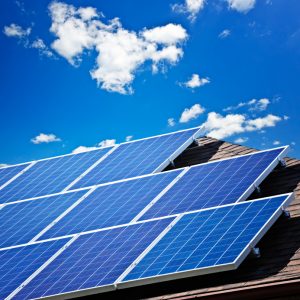 If awarded, the DOE grant would address specifically administrative structure, owner eligibility, financial underwriting guidelines, energy audit and measurement & verification requirements, contractor training and support, capital provider support, and marketing messages and strategy. The VAEEC would receive a portion of this funding from this DOE/DMME grant to implement some of the work in the grant.
If awarded, the DOE grant would address specifically administrative structure, owner eligibility, financial underwriting guidelines, energy audit and measurement & verification requirements, contractor training and support, capital provider support, and marketing messages and strategy. The VAEEC would receive a portion of this funding from this DOE/DMME grant to implement some of the work in the grant.
We feel that our response was strong due to our regional approach across three states and the problem that we are solving with a standardized model. DMME should know by late August or early September 2016 if we were awarded the grant, with funding provided by mid fall.
In the interim, the grant recommendations included the notion that VAEEC develop a comprehensive local government and energy contractor PACE education and outreach effort and offer technical assistance to local governments interested in PACE. An additional recommended task is to build grassroots efforts to compel localities to create PACE programs. The VAEEC is well positioned to build a grassroots campaign of energy service companies, clean energy advocates and property owners in local jurisdictions.
In late February, Arlington County issued a RFP to select a third party PACE program administrator. The creation of a PACE program in Arlington with a third party administrator creates another path forward to advance PACE in Virginia. Other localities can replicate the Arlington model, which calls for a third party to run their program and be paid from origination fees.
Finally, in late March 2016, the Richmond City Council passed a resolution calling for the Chief Administrative Officer to submit a proposal to City Council by January 31, 2017, with recommendations for creating a PACE program. The city is now forming a PACE stakeholder group and will study the Arlington model as part of its work plan to develop recommendations for implementing a PACE program.
Guest Blogger: Abby Johnson, Abacus Property Solutions (VAEEC Member – Individual)
April 2016
Schneider Electric
Business Silver
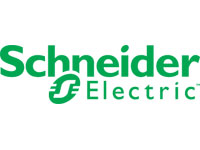 Schneider Electric is the global specialist in energy management and automation. With revenues of ~$30 billion in FY2015, their 160,000+ employees serve customers in over 100 countries, helping them to manage their energy and process in ways that are safe, reliable, efficient and sustainable. From the simplest of switches to complex operational systems, their technology, software and services improve the way their customers manage and automate their operations. Their connected technologies reshape industries, transform cities and enrich lives. They call it “Life Is On.”
Schneider Electric is the global specialist in energy management and automation. With revenues of ~$30 billion in FY2015, their 160,000+ employees serve customers in over 100 countries, helping them to manage their energy and process in ways that are safe, reliable, efficient and sustainable. From the simplest of switches to complex operational systems, their technology, software and services improve the way their customers manage and automate their operations. Their connected technologies reshape industries, transform cities and enrich lives. They call it “Life Is On.”
In the past 23 years, Schneider Electric’s Energy and Sustainability Services team has successfully implemented more than 550 energy savings performance contract (ESPC) projects across the nation and has helped clients around the world save nearly $2 billion. This project delivery method helps publicly funded entities make capital improvements over longer payback periods and offers many long-term benefits such as improved facility efficiency, occupant comfort, financial management and environmental protection.
Two areas where they focus are on schools and cities. Here is an excerpt from their in-depth and compelling Sustainability Mythbusters piece on the hidden value of sustainability for municipalities and schools: 
The word “sustainability” may conjure thoughts of recycling, reusable cloth bags and big piles of compost. But for many government entities, sustainability has little relation to these stereotypical green ideas and much more to do with operational efficiency, improved outcomes and a better bottom line. Not only are schools and municipalities adopting sustainability initiatives to satisfy government mandates and public pressures, but they are also using it as tool to become more competitive in today’s economy. In fact, government organizations practicing sustainability are outperforming their peers in areas like job growth, student recruitment, and increased tax revenue. Learn more about how your city, school or university can benefit from a modern sustainability program.
Schneider Electric’s Sustainability Mythbusters piece explores the top 5 misconceptions about sustainability, while highlighting specific case studies, trends, implications and facts around the topic.
1. There is no demand for sustainability in municipalities and schools
2. Sustainability does not make business sense
3. Sustainability is all about being green
4. Sustainability is too expensive
5. The impacts of sustainability are limited
Learn more at www.enable.schneider-electric.com or contact your local representative:
Barry Wilhelm
Schneider Electric
Energy and Sustainability Services, Team Leader
Phone: 804 486 1005 | Mobile: 540 798 3220
Email: barry.wilhelm@schneider-electric.com
Join us for the Spring 2016 VAEEC Meeting, your twice-yearly opportunity to network with other leaders in the energy efficiency industry, hear from speakers about the state of the industry in the Commonwealth, and help chart the course for the VAEEC. Thank you to Dominion Virginia Power for sponsoring the meeting.
Register Now.
When: Thursday, May 26
11am-2pm
Where: University of Richmond, Jepson Alumni Center, Robins Pavilion (directions below)
Working Agenda:
10:30 Registration (Coffee will be served)
11:00 Welcome, Board Nominations and Survey Results (Chelsea Harnish: VAEEC Executive Director)
11:30 General Assembly Recap and Governor’s Executive Committee on Energy Efficiency Update (Hayes Framme: Virginia’s Chief Energy Efficiency Officer)
11:45 Clean Power Plan Update (John Morill: Energy Manager for Arlington County, VAEEC Goverance Board and member of the Governor’s Clean Power Plan Stakeholder Group)
12:00 Lunch and Networking
12:30 Chambers of Innovation (Ryan Hodum: Vice President, David Gardiner and Associates)
12:50 Member Spotlight (Cynthia Adams: Pearl Certification)
1:10 Multifamily Housing Coalition Update (Zack Miller: Policy Director, Virginia Housing Alliance)
1:30 Member Updates (All VAEEC members are invited to share recent successes and innovations)
Lunch will be served.
The meeting is free and open to all. Non-VAEEC members are asked to make a small donation. We encourage you to invite friends and colleagues.
Register Now.
Directions to the University of Richmond’s Jepson Alumni Center:
From I-95 Southbound:
Take exit 79. Stay to the left to merge onto I-195 S, the Downtown Expressway. Continue on I-195 S for approximately two miles. Take the Cary St./VA-147 Exit. Bear right on the ramp and turn right onto Cary Street. Continue straight on Cary for approximately two miles and pass through the intersection at Three Chopt Road. At the bottom of the hill, bear right at the intersection onto westbound River Road. Continue straight for approximately .25 miles and turn right at the “University of Richmond” wall onto UR Drive. Follow signs for “Jepson Alumni Center” turning left onto Crenshaw Way. Proceed on Crenshaw Way to the Jepson Alumni Center.
From I-85 to/or I-95 Northbound:
Take exit 79. Stay to the left to merge onto I-195 S, the Downtown Expressway. Continue on I-195 S for approximately two miles. Take the Cary St./VA-147 Exit. Bear right on the ramp and turn right onto Cary Street. Continue straight on Cary for approximately two miles and pass through the intersection at Three Chopt Road. At the bottom of the hill, bear right at the intersection onto westbound River Road. Continue straight for approximately .25 miles and turn right at the “University of Richmond” wall onto UR Drive. Follow signs for “Jepson Alumni Center” turning left onto Crenshaw Way. Proceed on Crenshaw Way to the Jepson Alumni Center.
From I-64 Westbound:
Merge onto I-95 N toward Washington. Take exit 79. Stay to the left to merge onto I-195 S, the Downtown Expressway. Continue on I-195 S for approximately two miles. Take the Cary St./VA-147 Exit. Bear right on the ramp to turn right onto Cary Street. Continue straight on Cary for approximately two miles and pass the intersection of Three Chopt Road. At the bottom of the hill, bear right at the intersection onto River Road. Continue straight for approximately .25 miles and turn right at the “University of Richmond” wall onto UR Drive. Follow signs for “Jepson Alumni Center” turning left onto Crenshaw Way. Proceed on Crenshaw Way to the Jepson Alumni Center.
From I-64 Eastbound:
Take Exit 183/Glenside Drive south. Continue south on Glenside Drive to the fourth traffic light (Three Chopt Road). Turn left on Three Chopt Road. Continue through the intersection at Patterson Avenue. Continue straight for .5 miles. Turn right onto Boatwright Drive. Wind down Boatwright Drive and bear right at the “University of Richmond” wall – you are now on College Road. Pass by the lake (on the left) and proceed up the hill to the Weshtampton Gate (two brick columns) – turn left into campus between columns and follow signs for “Jepson Alumni Center” turning right onto Crenshaw Way.
From US 60 (Midlothian Turnpike) Eastbound:
Turn left on State Route 147 (Huguenot Road) and continue approximately seven miles and cross the Huguenot Bridge over the James River. At the next traffic light, take a hard left onto westbound River Road. Continue straight for approximately .25 miles and turn right at the “University of Richmond” wall onto UR Drive. Follow signs for “Jepson Alumni Center” turning left onto Crenshaw Way. Proceed on Crenshaw Way to the Jepson Alumni Center.
GPS ADDRESS:
49 Crenshaw Way
Richmond, VA 23173
 Guest Post by: Stuart Nuckols, Viridiant (Associate Member)
Guest Post by: Stuart Nuckols, Viridiant (Associate Member)

 Find out how their new name embodies the vision for their organization in this video.
Find out how their new name embodies the vision for their organization in this video.
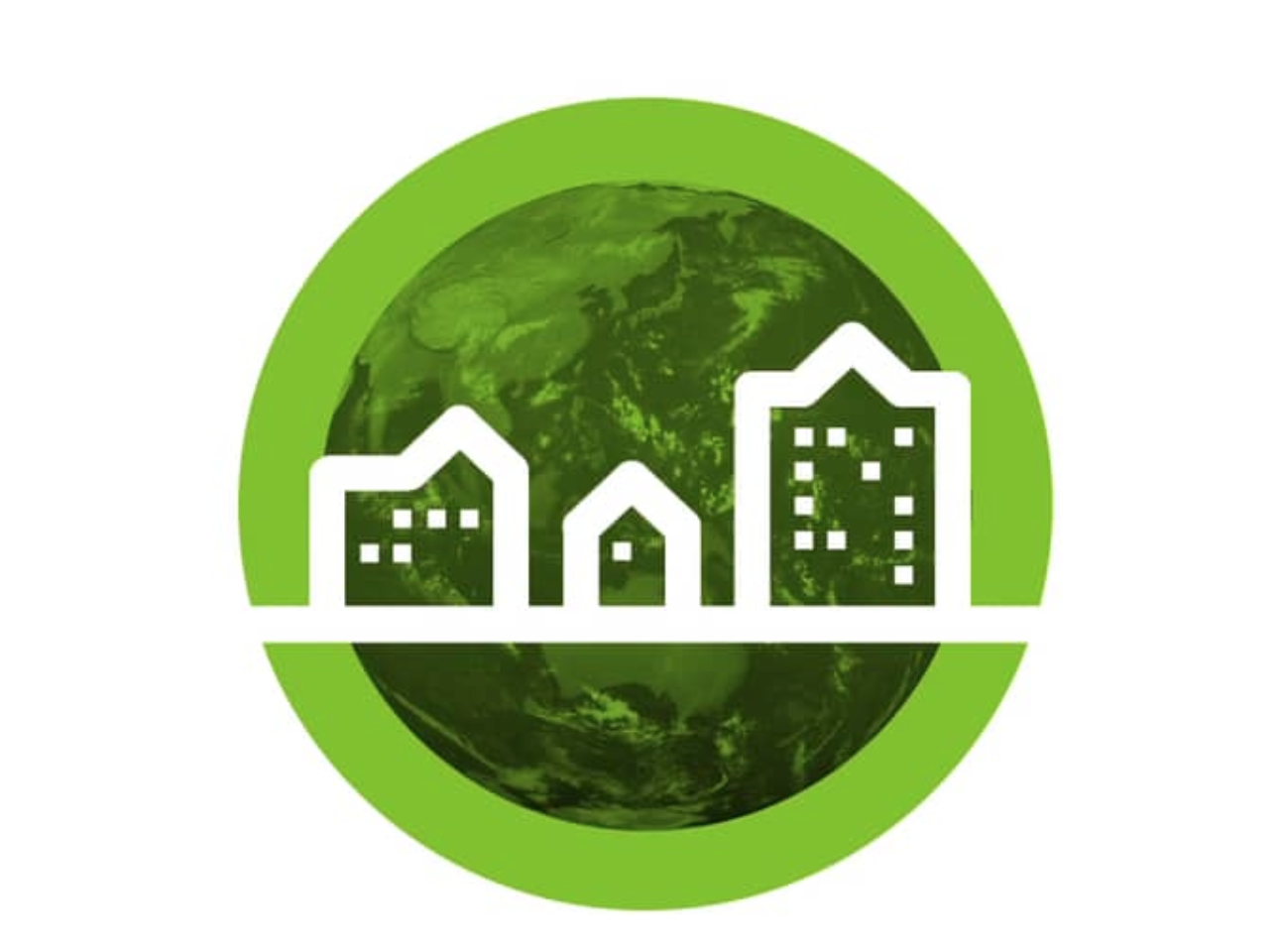
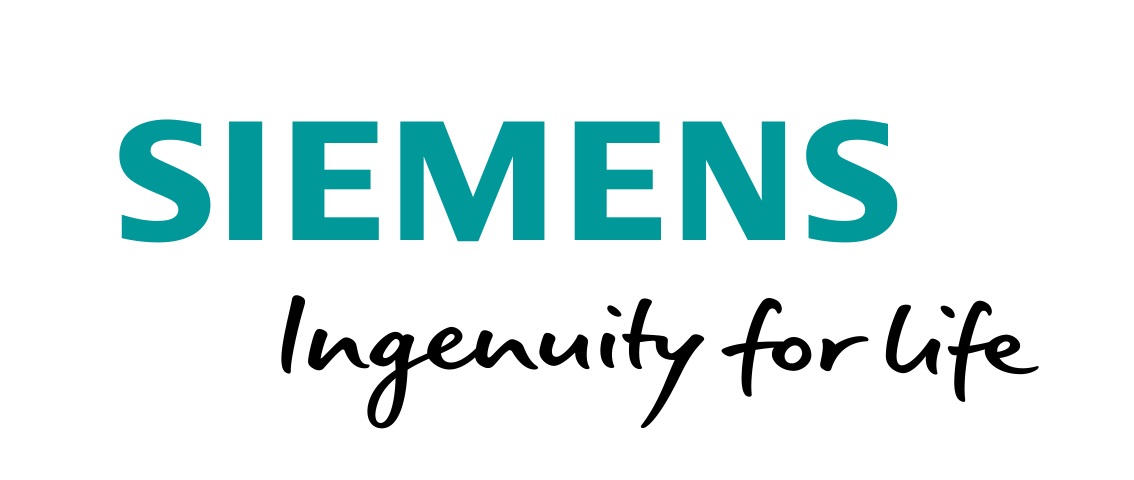
 For over 165 years,
For over 165 years, 
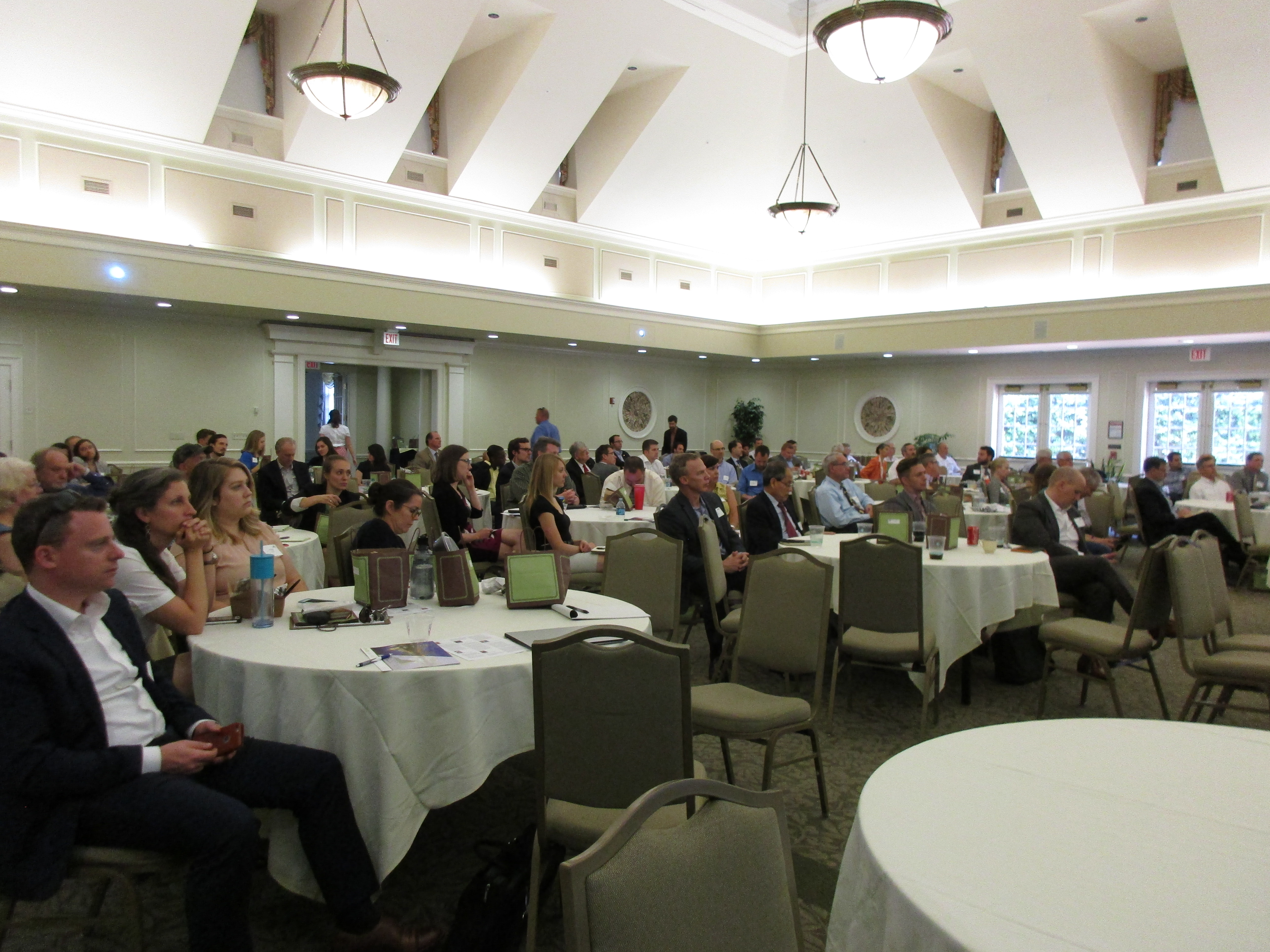

 gave an update on the 2016 General Assembly session and the work of the Governor’s Executive Committee on Energy Efficiency (GEC). Hayes told the crowded room about SB 395 and HB 1053, which were bills the Governor initiated. The final outcome for these bills, which wasn’t the initially hoped for outcome (
gave an update on the 2016 General Assembly session and the work of the Governor’s Executive Committee on Energy Efficiency (GEC). Hayes told the crowded room about SB 395 and HB 1053, which were bills the Governor initiated. The final outcome for these bills, which wasn’t the initially hoped for outcome ( three more presentations. First was Ryan Hodum with David Gardiner & Associates — also our newest member! Ryan presented on two of DGA’s initiatives:
three more presentations. First was Ryan Hodum with David Gardiner & Associates — also our newest member! Ryan presented on two of DGA’s initiatives:  We spent the last 30 minutes of the meeting giving our members the opportunity to brag a little bit. A microphone was sent around for members to give a 2-3 minute update on anything they are working on related to energy efficiency. Dominion Virginia Power, Columbia Gas and Washington Gas all gave updates on their energy efficiency programs and their latest proceedings before the SCC. Several other members gave updates as well including Trane, Viridant, Virginia Community Capital, and Loudon County Public Schools. We are pleased that so many members chimed in to talk about their work.
We spent the last 30 minutes of the meeting giving our members the opportunity to brag a little bit. A microphone was sent around for members to give a 2-3 minute update on anything they are working on related to energy efficiency. Dominion Virginia Power, Columbia Gas and Washington Gas all gave updates on their energy efficiency programs and their latest proceedings before the SCC. Several other members gave updates as well including Trane, Viridant, Virginia Community Capital, and Loudon County Public Schools. We are pleased that so many members chimed in to talk about their work.










 Since
Since 



